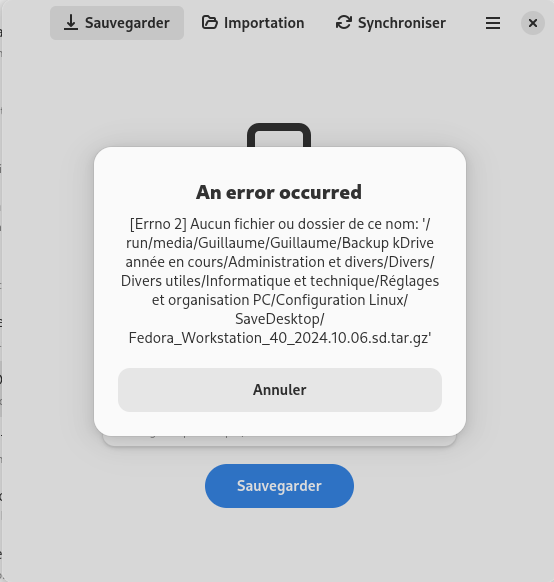Hi everyone,
I’ve been a happy user of Fedora Workstation since Fedora 36 on my Surface Go 1.
I really enjoy Gnome and everything is set up the way I want to.
Since I was really happy with my setup I just wanted to be able to replicate it easily through Clonezilla so that I could port it on any future computer I’d get.
Sadly, even with the help of really helpful and knowledgeable users on Lemmy, it hasn’t worked (https://sh.itjust.works/post/25963065).
So now I’m left wondering if there could be a distribution that I’d enjoy and which would be easy to deploy on another computer as I’d hate to have to configure everything on every computer I’d get.
I love Gnome but I wouldn’t be against trying something else if necessary.
What distribution could meet my needs?
NixOS. A big learning curve but replicable.
++. Yes, and not your standard Linux distro in design, never mind the hurdle of understanding Nix expressions and functional programming language. However, once tweaked, deployment on multiple machines is straightforward.
replicable.
As someone who spent time in OS Build/Relmgmt before security, I have a pressing desire to play the “how do you know” game, here.
Because the only way to have a functioning NixOS system is to have it be reproducible. That’s the only way it works; Nix is reproducible by design.
The ability to reproduce a system implies the ability to replicate it.
Various Internet strangers (who I trust implicitly) have said that it’s so.
I’d jump on the bandwagon of nixos, I use it myself and love it, does exactly what you’re asking for
However judging on some of your other comments it might be a better idea to just suck up having to manually rebuild until you understand the basics of Linux a little better
(nixos more or less requires you understand programming syntax for writing your system config)
(nixos more or less requires you understand programming syntax for writing your system config)
It’s technically not a real programming language but an expression language. The difference is that the former is a series of commands to execute in the specified order to produce arbitrary effects while the latter is a declaration of a set of data. You can think of it like writing a config file i.e. in JSON format.
The syntax isn’t really the hard part here. You can learn the basics that comprise 99% of Nix code in a few minutes.
The actually hard part is first figuring out what you even want to do and then second how the NixOS-specific interface for that thing is intended to be used. The former requires general Linux experience and the latter research and problem solving skills.It’s hard to say whether it’s difficult or not coming into it already knowing how to program
More people than not struggle to come to terms with what a variable is let alone all the stuff you can do in nix
There are definitely other hard parts, but I didn’t want to write a wall of text lol
While that’s certainly true, using NixOS usually does not involve many advanced concepts or requires you to understand them.
You can set
foo = barin a .conf file without knowing what a variable is either.
For reproducibility, nothing really beats NixOS. That’s not really what you’re asking for, as that would not involve Clonezilla.
If you’re frequently switching hardware, and want to have everything up and running, configured to your liking, in minutes, you’re gonna have fun with NixOS in the long term. But I’m not gonna sugarcoat it, it has a steep learning curve and does require you to enjoy some tinkering. Worth it, imo
Otherwise, just pick a distro that you enjoy and create a separate home partition, when it’s time to switch you do a fresh install and clone only the home partition. That’ll get you 90% of the way to have your old setup on the new device
But what is a home partition?
I mean for me the problem is backing up my settings (including for every app) and I don’t know where they are saved.
Backing up my pictures, documents and others isn’t a problem.
Your settings for the most part are in your home directory, generally when you install a Linux system everything that isn’t the bootloader is on one partition (system, installed applications, etc)
Your home directory is for anything specific to your user, meaning your downloads folder, your pictures, documents and also your .config folder which holds 90% of the config files
There are some weird ones that have directories outside of home, afaik that’s stuff like network manager remembering your saved networks that runs outside of your user context
Usually your settings are saved under ~/.config
I’m going to mention
Ansibleas I haven’t seen it mentioned, and it can be used to locally manage a reproducible build.It has already been mentioned, but as a minimum to replicate your system you need two things:
- Transfer/copy your entire
/homedirectory as there is where the majority of the configuration files of your system pertaining the software you use (there could be configs you could need on/etcand on/usr/localor other dir), that is why it is recommended to partition your disk on installation of your distro, so the/homedirectory is already separated, as if you reinstall in the same machine you don’t lose any configuration in addition to your personal documents/pictures/etc - Have a way to automatically install a list of programs/apps/drivers/libraries, and that is what something like a bash script, Ansible, nixOs, etc. could help you with.
The truth is that using any of the tools in the second point requires learning a bunch, so if your skill level is still not there, there is some work to do to get there.
I’m going to mention Ansible
Oh for the love of god, don’t. Ansible is 2002 technology used in 2024. It’s so clunky and janky that I’m relieved I can get chatgpt to boilerplate my stuff and save me time actually staring at fucking YAML all day. Use Anything Else before your brain rots.
source: it’s like half my day job now and I should’ve charged more.
What would you recommend that is not NixOS or a Bash script and can be used agnostic of distro?
- Transfer/copy your entire
Personally, I use Fedora Silverblue and use bash scripts for reproducibility. To set up a new system, all I need to to is install, reboot, run my bash script, reboot, and my system is 90% configured. With bash scripts, I am able to reproduce more of my system than I could when I used NixOS.
A lot of people recommend Nix, but the thing about Nix is that you’re only declaring how the system is configured. Not your home folder. You need to rely on third party tools for that.
Bash scripts can configure system and home folder. They can also be used on any distro, whereas a Nix configuration file only works on NixOS.
Though the worst part about any new install is just signing back into everything, especially an annoyance when you have proper 2FA setup. Bash scripts or Nix can’t solve that unless you migrate data over.
What is a bash script? Is it something I’d have to write mysel using the terminal? Sorry but my skills are quite limited for now.
Yes, it’s something you write yourself. Bash is the language you use when you use the terminal. A bash script is just many lines of bash commands.
A bash script could be as simple as
dnf install package1 package2 package3 dnf remove package4 package5 package6This script automates installing some packages and removing some packages. The bash script I use does a lot more, such as running commands to configure Gnome how I like it.
If you’re not comfortable with the terminal, I would definitely recommend staying away from NixOS. To declaratively/reproducibly set up the system, it uses a language called Nix that is a fair bit more complicated than bash. It’s also just very different from traditional Linux systems like Fedora or Ubuntu.
What is a bash script?
At this point in time, I need to stop you.
There’s a massively-increased risk of you being misled by someone else’s agenda without knowing it’s not the simplest and most effective solution to your problem because there’s a lot of technical stuff you may not know and can’t pick from available options based on their nuances. So:
- find a real person you trust who knows this
- ask them
Whatever they tell you, they’ll be able to support. Ensure you’re the one typing so you learn things, and ask every question you think of all the time.
Stop asking random strangers which solution is best, because you’re going to get a lot of short-sighted clique answers that DO NOT HELP YOU.
NixOS is the sort answer. It’s reproducible across hardware. But I’ve never tested it.
Cloning the system and home partitions always worked fine for me with openSUSE Tumbleweed with KDE Plasma desktop. Another option openSUSE offers is AutoYaST
AutoYaST is a system for unattended mass deployment of openSUSE Leap systems. It uses an AutoYaST profile that contains installation and configuration data.
NixOS is exactly what you want.
You declare your configs in a way that you can just copy them to another computer and it willbe configured the same way.
I’ve never tried it my self, but I might for my next machine.
I just discovered the source of all your problems by reading your previous post.
The Surface Go 1 is a UEFI system. The Acer Aspire 5737z is a legacy BIOS system and thus can’t boot UEFI partitions. If your Aspire was a UEFI system, what you did probably would have worked just fine - no need for a special snazzy distro (no offense, NixOS users).
I’m actually extremely surprised no one noticed this before me.
From here, you have a few routes:
- Flash the install to the drive, and try to downgrade it to a legacy BIOS system.
- I would not recommend doing this. Your life will probably become a living nightmare. If you love pain, though, here’s a forum post to get you started: https://askubuntu.com/questions/910409/change-from-uefi-to-legacy
- Reinstall Fedora and copy just your Gnome config over - from what I can tell, it’s just a few directories.
- This is a Python script that says it exports all that crap for you, but what do I know? I just use XFCE.
- Buy a slightly newer device (maybe 2012/2013-ish at the earlist, probably originally designed for Windows 8.x) that support UEFI so you could just use the image.
- Honestly, I am a bit conflicted on this option, as I don’t exactly like not reusing the Aspire. However, this may be the easiest way out, and maybe you could put the Aspire to use as a server in a home lab instead.
- Try NixOS like others have been saying. Learning things is fun when you have the time - I don’t, and so stick with Debian.
Oh well thanks for this information. I’ll see what I’ll do but I’m determined to keep using the Aspire for a few things.
- Flash the install to the drive, and try to downgrade it to a legacy BIOS system.
Any of the many immutable distros (vanilla os, fedora silverblue, bluefin, aeon, endless os, pure os, …) will all obviously work.
Most of your customizations will live in your home directory anyway, so the details of the host OS do not matter too much. As long as it comes with the UI you like, you will be mostly fine. And yku said you like gnome, that installs many apps from flathub anyway and they work just fine from there.
For development work you just set up a distrobox/toolbox container and are ready to go with everything you need. I much prefer that over working on the “real system” as I can have different environments for different projects and do not have to polute my system with all kinds of dependencies that are useless to the functionality of my system.
NixOS is ofmcourse also an option and is quasi-immutable, but it is also much more complicated to manage.
If you want something simple that does this for you: check out SaveDesktop. I’m not sure if it will meet every need, but it works for me when I need to switch.
Would you know why I’m getting that error? :

I’ve already allowed access to all system files through Flatseal.
I think it needs access to all your host files as well, let me see if I can replicate that error.
I was not able to reproduce that bug, but I also did not change anything in flatseal, I think you shoulf just reset the permissions and/or reinstall and just try it normally.
I’ve managed to create an archive with SaveDesktop, but only on my internal disk drive as I think the external drive was what was creating the problem.
Do you know what would be the difference if I backup or don’t my home file? I’d have to find a way to back it up outside of home, but it’s complicated since it doesn’t work with an external drive.
I mean I don’t think I can backup home with Savedesktop inside home, so I’ll have to look at my file structure once I can get back in front of my computer.
I think the reason why it didn’t work on your external drive is that is a different permission to system files. Something to do with usb stuff.
When it comes to backing up your home files, I’m not sure what you mean by home file? Do you mean the home folder? Cause if so I don’t think SaveDesktop can do that as that includes all your files, not just your configs. You’d have to use another tool to move those folders.
Sorry as I’m struggling to express clearly.
SaveDesktop has the option to backup your home folder.
I was thinking that the save destination had to be outside of the home folder if I wanted to also backup my home folder. Otherwise it could end up in some kind of loop where the archive would contain itself and get bigger and bigger. That’s why I thought the SaveDesktop archive with the home folder shouldn’t be saved inside home.
I hope It nakes more sense 😅
I tried it normally but then it had another problem so that’s why I tried to gove it more access through Flatseal as recommended on the SaveDesktoo Github page.
I’ll have a deeper look when I get the time. Thanks
Oh from reading what’s in the link, it looks like it’s exactly what I need.
I’ll go deeper into it.
Seperate home is a must imho. Fedora had kickstart but alas a little old. This may help. https://discussion.fedoraproject.org/t/here-is-how-to-easily-create-a-bootable-clone-of-your-fedora-system-disk/111308
As a counterpoint to the majority of answers here, I’d love to suggest GNU Guix as the best answer. Like Nix, but enhanced for freedom with a formidable governance model. Built on freedom. Built to last forever. Also easier and more beautiful
It is kinda painful and the repos are very slow
WDYM the repos are very slow?
i’m using it as a daily driver for a couple of years now
How’s it’s hardware support GNU Trisequel was bad in that regard
it is built so that non-free packages can be made easily available (e.g. the non-guix channel). being sort of a meta-OS, already a bunch of operating systems were built on top of it, arguably easier to just get started as a novice
Nixos and mynixos website helps you create your config if you don’t know how or don’t want to
Could I make an image of my Fedora Workstation install?
I’m struggling to understand what all these ublue or other images are…











